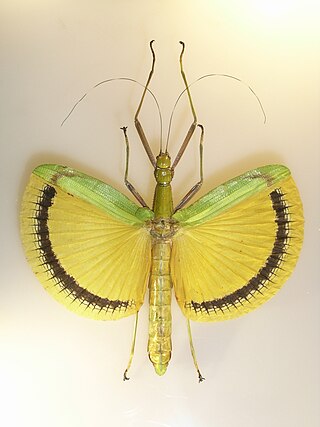
Necrosciinae is a subfamily of the stick insect family Lonchodidae, with its greatest diversity in South-East Asia.
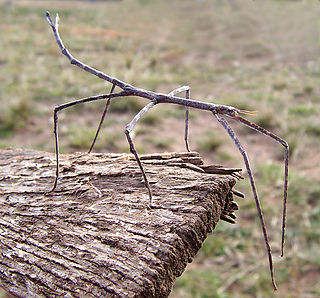
Ctenomorpha marginipennis, the margin-winged stick insect, is a species of stick insect endemic to southern Australia. The species was first described by George Robert Gray in 1833.
Asceles is a genus of stick insects in the tribe Necrosciini. Some of the species of Asceles have a distribution in Malaysia and Singapore.

Pulchriphyllium giganteum, commonly known as the Giant Malaysian Leaf insect, is a species of leaf insects described from Malaysia by Hausleithner in 1984 and placed in the genus Pulchriphyllium since 2021. Pulchriphyllium giganteum is the largest species belonging to the genus Pulchriphyllium reaching 105 mm in size. They are found most abundantly in the west Malaysian tropics. The females typically have large elytra that lie edge to edge on the abdomen and tend to lack hind wings making them usually flightless. Males have small elytra and sometimes transparent non-leaflike functional hind wings. Pulchriphyllium giganteum found in the wild tend to be mostly females and the first male of this species was not found until 1994. In captivity, the species has primarily been observed to reproduce through parthenogenesis meaning the females are asexual. The primary reproductive pattern in the wild is unknown. Eggs tend to be brown or black and glossy and resemble seeds. They hatch around 6 months after breeding. Newly hatched young nymphs tend to be wingless and brown or reddish in color. They develop their green color after feeding on leaves. Both the adult and larval stages are phytophagous meaning they feed on plants. The main plant food sources for this species are oak and bramble tree leaves.

Aschiphasmatidae are a family of stick insects belonging to the suborder Verophasmatodea; they can be found in Indomalaya.

Cryptophyllium westwoodii is a species of leaf insect in the family Phylliidae. It is distributed from southern China, the Andaman islands, Myanmar, Indo-China, Sumatra and the Riouw Archipelago.

Pylaemenes is a genus of stick insects in the family Heteropterygidae and subfamily Dataminae. It combines small to medium-sized, often brightly colored Phasmatodea species. Their representatives are found in large parts of Southeast Asia.
Ramulus westwoodii is a species of stick insect first described by James Wood-Mason in 1873 and named in honour of John O. Westwood.

Sceptrophasma is a genus of stick insects belonging to the tribe Gratidiini. The species of this genus are found in Central Asia and Southern Asia.

Heteropterygini is the only tribe within the subfamily of the Heteropteryginae. With 19 representatives described, this subfamily includes the fewest species of the three subfamilies, but includes the largest and most striking species of the family.

Hoploclonia is the only genus of the tribe Hoplocloniini and brings together relatively small and darkly coloured Phasmatodea species.
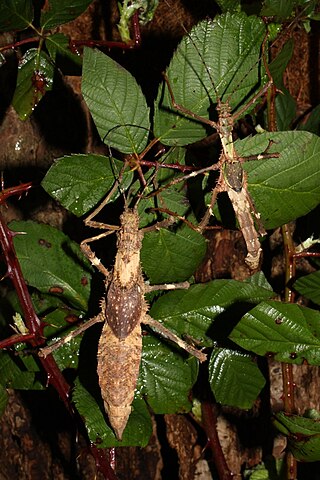
Haaniella is a genus of the Phasmatodea family Heteropterygidae from Southeast Asia.

Orestes mouhotii is an insect species belonging to the order of Phasmatodea. Because of its synyonym Orestes verruculatus, it is the type species of the genus Orestes. Because of its compact body shape, the species is sometimes referred to as small cigar stick insect.
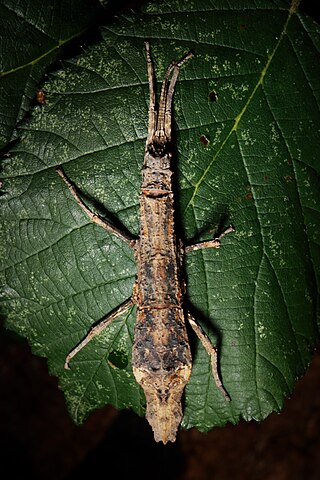
Pylaemenes elenamikhailorum is a species of stick insects native in Sepilok on Borneo. In application of the more recent differentiation between the genera Pylaemenes and Orestes the species is sometimes also called Orestes elenamikhailorum.

Aretaon muscosus is a stick insect species from the family Heteropterygidae, which is native to Borneo.
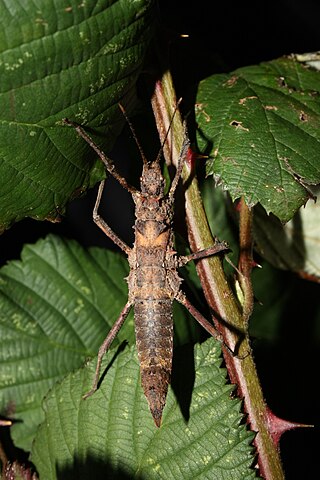
Hoploclonia cuspidata is a stick insect species native to the north of Borneo and is also called Brunei Hoploclonia stick insect.
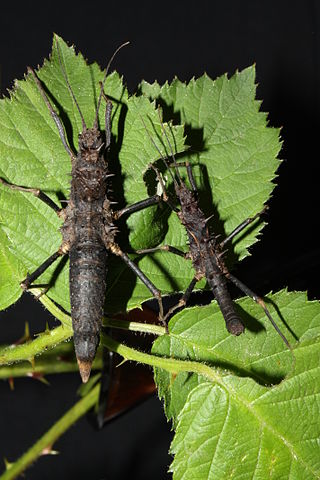
Hoploclonia abercrombiei is a stick insect species known from the northwest of Borneo, more precisely from only one place in the Malay state Sarawak.
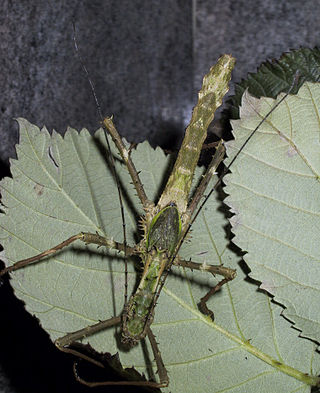
Haaniella erringtoniae is a stick insect species. It is a typical representative of the subfamily Heteropteryginae. The occasionally used common name Errington's Haaniella refers to the species name.
Tirachoidea westwoodii is a species of stick insect in the order Phasmatodea. It is endemic to India, Myanmar, Thailand and Vietnam. The eggs of the stick insect are spheric, ca. 5 mm in length and have a three-lobed micropylar plate. The chorion of the eggs are hard to cut and consist of the three layers mineralized with calcium carbonate and calcium oxalate.
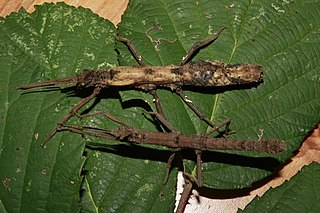
Pylaemenes mitratus is a species of stick insects (Phasmatodea) native to Malay Peninsula and Sumatra. The species is also known by the common name Money Plant Stick Insect, which refers to the most well-known food plants, Epipremnum aureum, which is also known as money plant.

















